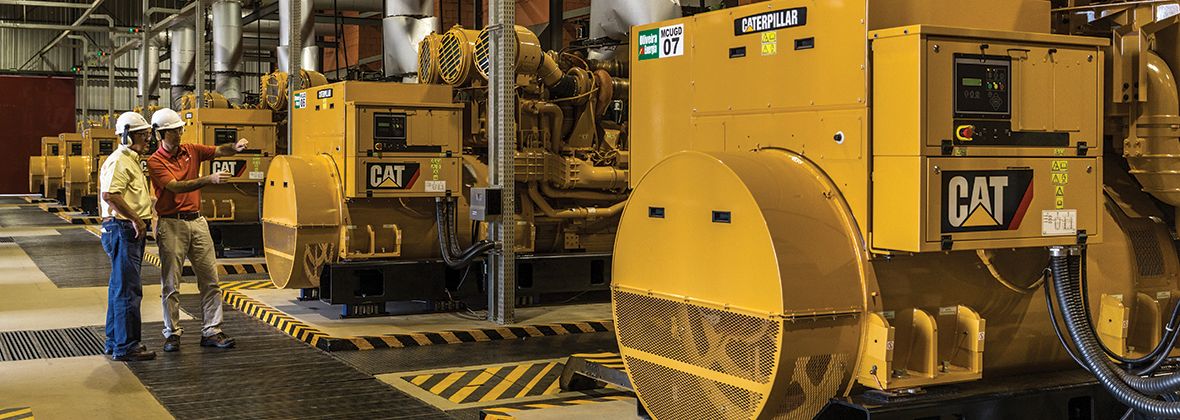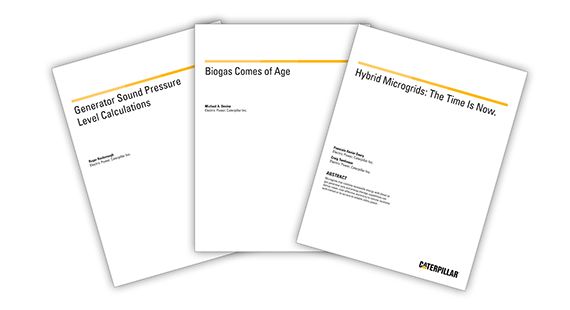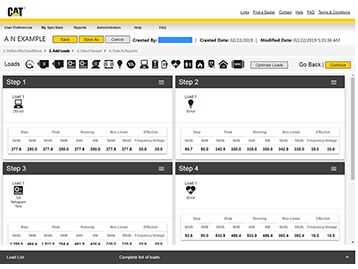Environmental Conditions
Generators are electromechanical machines that require maintenance and experience a wide range of environmental conditions. Generators with unit-mounted radiators require a large volume of outside air to be brought into the room and across the generator surfaces. Outside air temperatures vary widely, as does humidity. Outside air also can contain moisture, humidity, pollen, dust, insects, and other particulates.
Generators themselves generate substantial heat, vibration, and noise. These factors combine to create adverse environmental conditions that will inevitably affect system reliability. It is not recommended to provide screens or filters on intake grills and louvers to alleviate dust and debris, as those methods will become clogged and prevent proper airflow, which may adversely affect a generator system's cooling and capacity.
Maintenance
When generator systems need to be maintained, they are taken out of service. This prevents them from starting during an outage and necessitates careful planning by the facility, which usually results in work performed outside of normal hours that require interim life safety measures.
The 2016 edition of NFPA 110: Standard for Emergency and Standby Power Systems, Article 7.13, requires that additional sources of standby emergency power be available during generator maintenance. Paralleled generator systems may provide redundancy of required systems. This means that regular maintenance can be provided during periods of convenience, which increases the likelihood that maintenance will be performed on a regular basis.
Expansion of Existing Systems
Projects that replace or add onto existing emergency power supply (EPS) and emergency power supply systems (EPSS, as defined in NFPA 110) are the most challenging because they require the design team to consider all impacts to the existing system. Emergency power system outages are the most difficult aspects to manage for health care, critical operations, industrial, or mission critical buildings.
Taking a standby emergency power system offline for any amount of time will require risk assessments with the owner. These events usually trigger disaster preparedness teams that outline plans for managing electrical outages without available backup power. Impacts to IT, phone, radio, lighting and egress, and hazardous safety will need to be discussed and evaluated by the team. The nature of the risk also is affected by the proposed duration of the emergency power system outage and how long it would take to make connections in the event of a utility outage.
Due to these complications, providing a new EPS and EPSS may be easier than trying to add to an existing system. Additionally, when connecting to existing distribution systems, impacts to selective coordination should be evaluated as they will likely impact how and where connections will be made.
Design Choices
Once the decision is made to go with paralleled generator systems, the design team and owner must make decisions regarding physical location, fuel system requirements, electrical-demand requirements, system voltage requirements, desired system redundancy, and the amount of future growth potential. Determining the operating voltage of the EPS and EPSS is sometimes, but not always, done by matching the normal service voltage.
Discrepancies occur when EPSS are located long distances from the building(s) they serve, and in these cases, higher voltages—even medium-voltage levels—may be prudent. Generator voltages above 208/120 V in the United States will result in the need for step-down transformers, which influence the generator load and take up physical space. Unless long feeder distances justify medium-voltage levels, the EPS voltage usually matches the mechanical equipment, process equipment, and any traction elevator systems.
Paralleling
Generator sets can be paralleled through traditional switchgear with motor-operated breakers and paralleling logic housed inside the switchgear or in remote cabinets. Another option is to allow the unit-mounted generator controllers to provide paralleling control, which can reduce total system cost. Onboard paralleling allows the design team to plan for a modular generator system, which can allocate space for several additional generator packages that can be added as the load increases.
While stand-alone paralleling gear usually comes at a higher initial cost, this equipment can readily provide an entire system overview, and the breakers and controls can be located in a conditioned space outside of the EPS room. Due to the environmental conditions a generator must encounter, it can be prudent to provide physical protection of sensitive electronics.
Conversely, unit-mounted controllers offer enhanced redundancy because the loss of one system controller may not eradicate the paralleling function of the remaining generators. Because of the likelihood of electronic failures, paralleling systems for critical functions should be able to be manually controlled. The steps required to manually start, connect, and parallel generators should be clearly defined and made readily available in the generator control space. Proper training should be provided to all approved personnel.
Location
Choosing a physical location for the EPS and EPSS requires a lot of forethought and consideration of impacts on adjacent systems. Besides the physical requirements of the electrical distribution equipment, generators are noisy, smelly, and large. An acoustical noise study should be performed to determine the maximum permissible noise levels, and the first step in this process is determining the expected noise levels from the generator system. The components of the generator system that are of acoustical concern include the radiator fan, exhaust system, engine and generator surfaces, and system vibration levels.
Once the noise sources are characterized, the design team must evaluate the permissible noise levels in adjacent rooms, buildings, and properties. Noise-abatement solutions include muffler systems with high-insertion-loss values, acoustical louvers with sufficient free-area and sound-attenuation levels, and building walls with sufficient transmission loss. Vibration isolation of hanging piping can alleviate structure-borne noise transfer.
Further, the proximity of generator exhaust to the building's ventilation-air intakes must be taken into consideration along with prevailing wind directions. When generator systems are located within the building they serve, providing isolation of noise, heat, and exhaust fumes adds significant cost and complexity to the building design.
EPS and EPSS locations should also take flooding into consideration, including efforts from firefighting as defined in the 2012 edition of NFPA 99: Health Care Facilities Code, 6.4.1.1.8. Wind-speed graphs, such as wind rose graphs, can identify possible problematic building orientations in which high wind speeds and directions could have an adverse impact on the EPSS.
Airflow
Paralleled generator systems may include unit-mounted radiators or remotely located radiators. The airflow requirements of unit-mounted radiator fans are large, and the generator set's capacity is affected by the number of restrictions to radiator airflow, also known as pressure drop. The generator set will be designed to accommodate a maximum level of pressure drop experienced by the radiator fan. Factors that influence airflow pressure drop include intake-louver free area and design, air-pathway configuration, and discharge-plenum louver-free area and design.
Acoustical louvers further increase system pressure drop and available free area, which can result in louver systems that are several times larger in dimension than the radiator itself. When the design allows for future growth, the designers should consider how additional air will be brought into the EPS room as generator capacity grows.
When generator exhaust systems are required to comply with U.S. Environmental Protection Agency (EPA) Tier 4 requirements, there are several additional components that greatly increase the physical size of the exhaust system. If the owner is considering operating the generators in a manner that requires EPA Tier 4 compliance, the design team should allocate space for these additional systems.
Fuel Oil
Code requirements for fuel system capacity vary based on the system's class designation outlined in NFPA 110-2016, Article 4.1, and requirements in the Facility Guidelines Institute guidelines that define run times for health care facilities. Depending on the nature of the building and the availability of fuel oil, the owner and design team will need to determine the desired run time duration.
The maximum amount of fuel oil that can be stored in a building is driven by NFPA 110, Article 7.9.5, which limits capacity to an aggregate total of 660 gal/building. Day tanks are offered with 150%-capacity leak capture and leak detection. Fuel-oil supply pumps are usually located on the day tank and are configured in a duplex-type system where a redundant pump is provided. Achieving long run times (24 hours or greater) will require additional fuel-storage capacity, which can be exterior aboveground or belowground fuel tanks sized to meet or exceed run time demands. Both concepts have benefits and risks, which will vary based on location.
Additionally, when storing large amounts of fuel for disaster preparedness, the fuel will need to be routinely cleaned to maintain fuel integrity. It is common for a fuel-polishing system to be provided, which will provide active filtering of the entire storage system on a scheduled basis. These systems are not very expensive and they prolong fuel life as well as the generator's fuel filter life and reliability.
When routing fuel lines for paralleling generator systems, the design team must consider the reliability of the fuel-return piping. The ideal scenario is one in which fuel-oil-return piping is routed to allow for gravity-only drainage. This means that the fuel storage is below the level of the generator system and return-fuel piping is routed below the level of the generator and day tank return connections. This arrangement is benefited by recessed trenches for fuel-line routing to eliminate trip hazards within the room.
When fuel-return piping is routed above the level of the generator and the day tank, a fuel-oil-return pump is required along with solenoid valves and, sometimes, check valves. In a properly designed fuel-oil system, the only time fuel oil would be returned to the main tank is in the event of a control failure where the supply pumps are stuck in the "on" condition.
It is not recommended to install the day tank at a level above the generator, as additional check valves are required to prevent flooding the engine. Fuel-oil-storage systems are commonly shared with boilers and act as secondary fuel sources for building heating systems. Designers must ensure that generator fuel systems do not pose negative impacts on boiler fuel-oil systems.
Richard Vedvik is a senior electrical engineer and acoustics engineer at IMEG Corp. He is a member of the Consulting-Specifying Engineer editorial advisory board.










